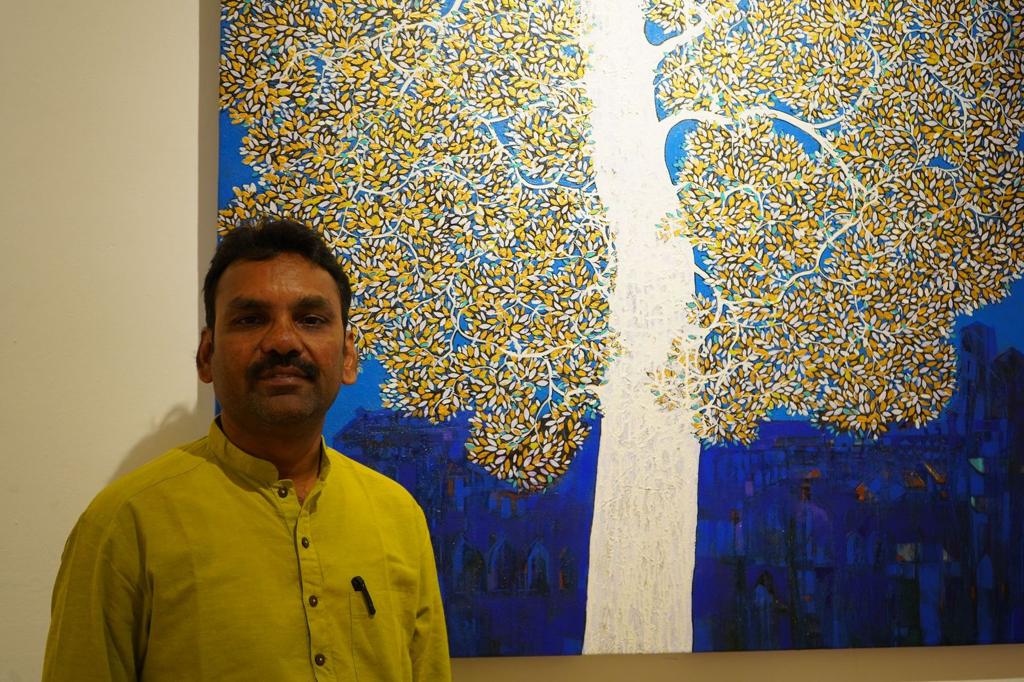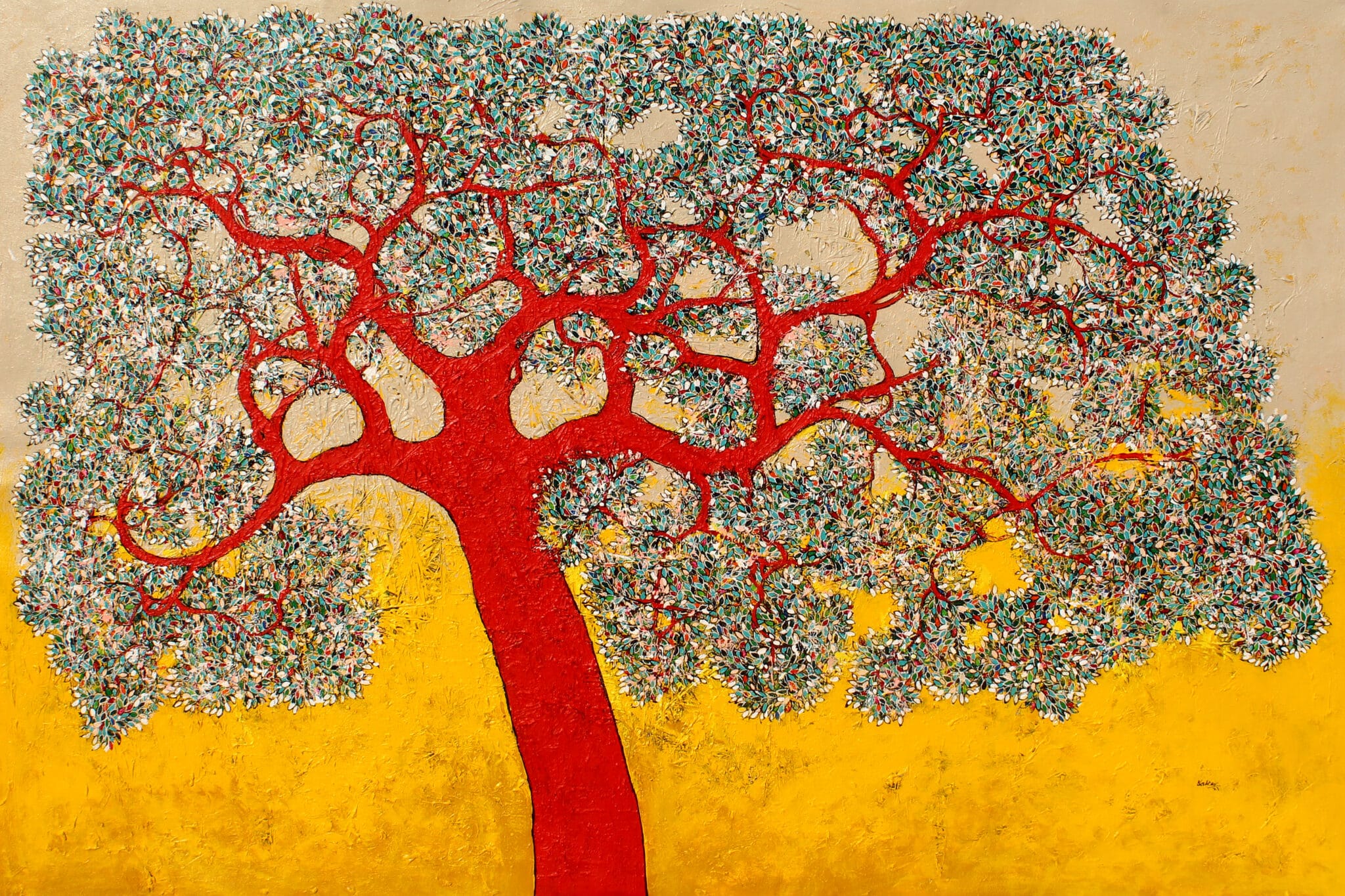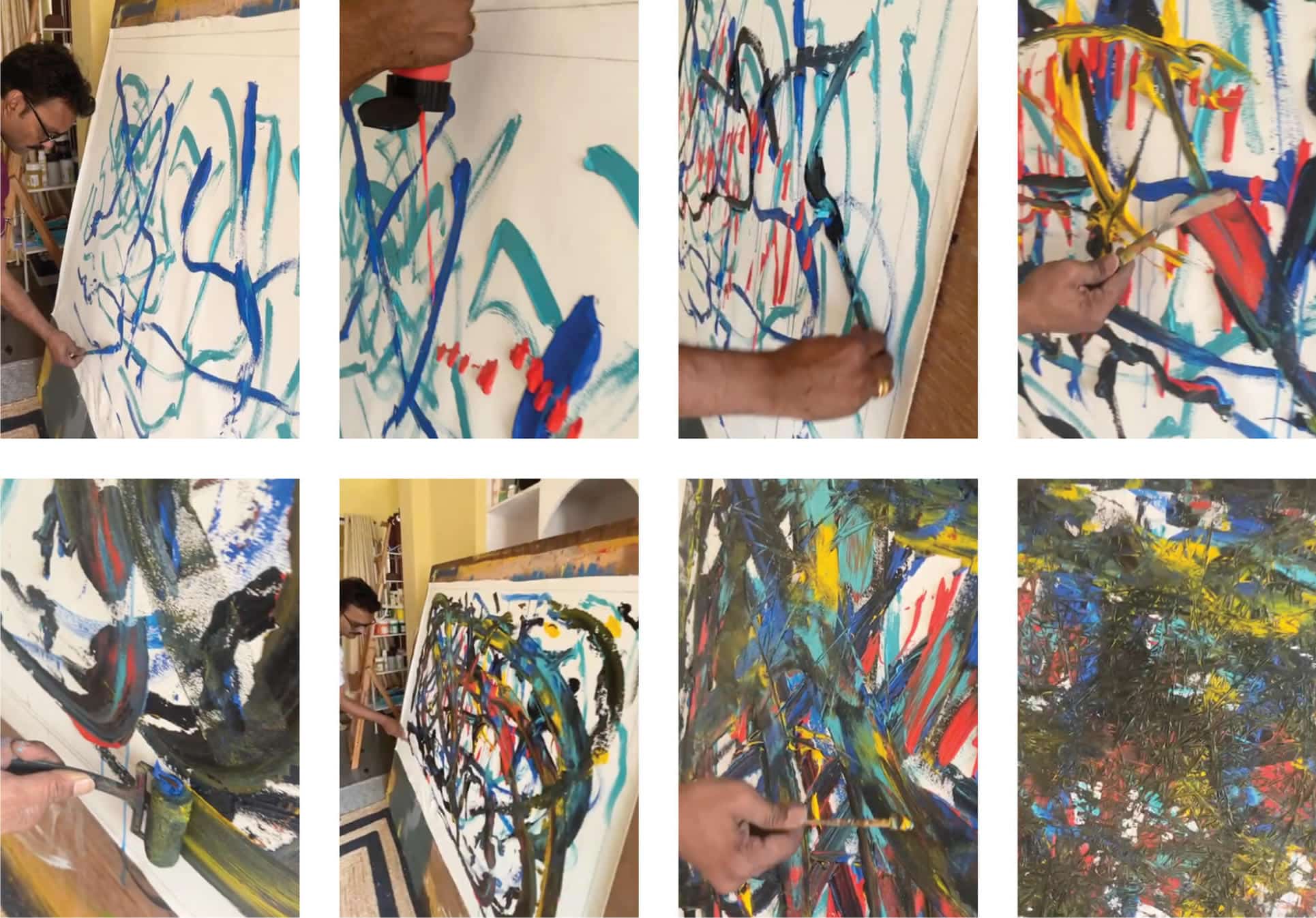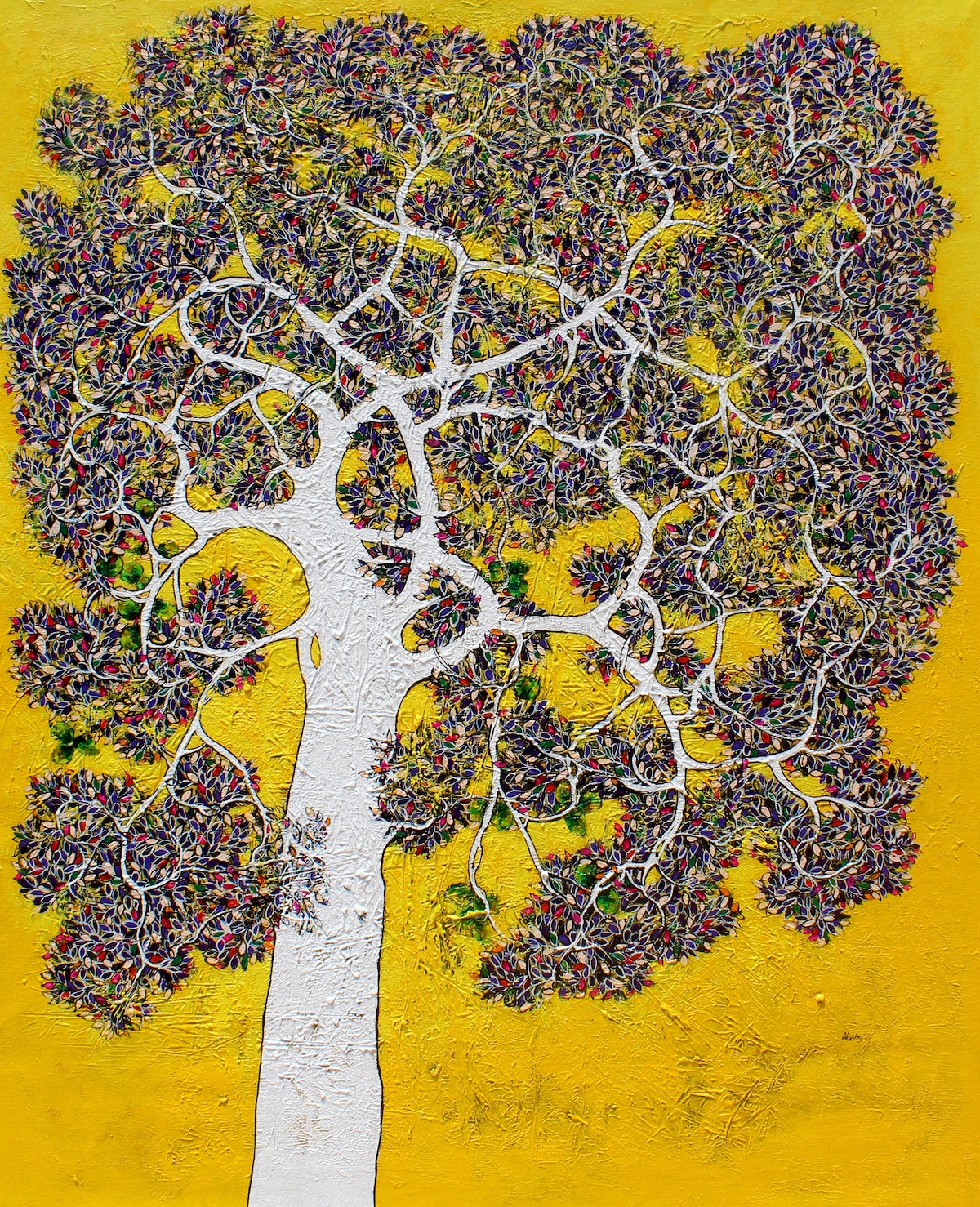
INTERVIEW WITH CONTEMPORARY INDIAN ARTIST BHASKAR RAO
The image of a tree, brightly colored with its branches reaching outwards, is what comes to mind at the mention of contemporary Indian artist Bhaskar Rao. As an established painter who studied at art schools in Visakhapatnam and Hyderabad, he is known for bringing the magic of the tree alive on the canvas, a loving remembrance from his childhood. He has continually reimagined this subject over the years, as he encounters wonderful and unusual trees around the globe.
In this recent interview, Bhaskar spoke with respected art historian and writer Sandhya Bordewekar about the influence of his teachers on his art, his own growth as an artist, and the evolution of the tree in his art.

Bhaskarji, where did you spend your childhood and schooling? Tell us about your early years.
I was born in Baguvalasa village in Andhra Pradesh, where my parents lived in our ancestral home. My grandparents held large tracts of agricultural land with cashew and mango groves. As the crow flies, the nearest large city is Visakhapatnam (Vizag), about 120 kilometers (75 miles) away. In school, I was quite good at art. Two of my uncles taught art in local government schools. They often came to our home during the summer and would go out sketching. I would follow them and watch what they did. Of them, Venkata Rao, helped me learn sketching.
My village was in the tribal belt, and once a week, the local tribals would come to the village market to sell the crafts they made and the forest produce they collected. They became popular subjects for sketching. It triggered my interest in art and I decided to go to an art college after my schooling.
Can you tell us a bit about your artistic journey and the challenges you had to face?
Fortunately, there weren’t many challenges. My father, though an agriculturist, was agreeable to my joining Visakhapatnam art school, on the condition that I supported myself after I finished my studies. My mother was a little unhappy, because she wanted both her boys to be doctors or engineers, as is the common desire. Today my younger brother is a senior journalist.

What was your experience at Visakhapatnam like?
At Vizag, most of the faculty were graduates from the Baroda art school — V. Ramesh, Sudhakara Reddy, Sistla Srinivas, Ravinder Reddy, the late Ravishankar Pattanayak. They would work in front of us, and we had easy access to their studios. They took us to all the major exhibitions, the triennials, the biennials, to Santiniketan, to Baroda, exposing us to what other artists were doing and what was happening in the world. We learned about the thinking and the physical hard work that goes into the creation of art, but they never instilled the idea of commerce in us.
Was there any reason to move to Hyderabad to complete your Masters? Did it help you in developing your maturity as an artist?
I graduated in 1999 and moved to Central University, Hyderabad to pursue my Masters. Vizag was very regional, while Hyderabad is a huge city with more artists and a few galleries that held shows. But Hyderabad also had faculty from Baroda — DLN Reddy, Laxma Goud, Shyam Sundar — so there was a good continuation of the ideation. I wanted to develop my own signature style. But the worry was, how will I sell my work? There was a deep lack of confidence, of motivation.
After I finished college in 2001, I took up a job in a school to support myself, and tried my hand at design and animation too. My first break came when a local gallery in Hyderabad invited me to be part of a group show. My works generated a good response, and so they offered me a solo show. I was scared at first but as I began working towards it, my confidence surged. The image of the tree first germinated in the 15 works I created for this solo presentation.
Later, in 2014, someone called me to apply to exhibit in the Art Revolution show in Taipei, Taiwan, a vast international exhibition. There was only one day to go before the closing date and I scrambled to get my application in place with all supporting documents! Both the canvases I had sent were selected for the show, and ultimately bought as well, with a request for 8 more. These were the tree canvases. I booked my ticket to Taipei, the first time I traveled abroad. Since then, there has been no looking back.

The tree is the primary subject of your artwork. Can you tell us how you came upon this theme, and why you find trees so fascinating?
My Masters’ thesis was focused on the Kalpa Vruksha, the wish-fulfilling divine tree occurring in Hindu, Jain, Buddhist and Sikh religions. I had done considerable research on the tree as it appears in literature and art. So when I began to look for alternatives to the traditional landscape format, the single tree caught my attention. I discussed this with a senior artist, the late Surya Prakash. He was very appreciative and encouraged me to go down that road. The dramatic impact of a single tree in a vast landscape could not be denied. Laxma Goud similarly told me not to listen to the negativity and just concentrate on doing what I believed in. In fact, I made a series of prints of trees in black and white under his guidance!
Also, trees look different in every season — when they are flowering and fruiting, with leaves all shed and the bird nests visible, when they are fresh with new leaves, or washed down by a heavy downpour. In places like Bhutan, they are decorated with flags. People have a genuine connection with trees, there is a positivity around them.

There is a lot of texture in your work that gives it a shimmering extra dimension. Can you describe the process by which you achieve this?
I use a lot of acrylic paint. A lot of pigments as well, and even rollers or the bark of trees to get certain effects. I layer the canvas many times over and that gives that shimmering dimension!
Who are the 3 people in your life you have had the most influence on you?
There have been more than 3… my wife, Dhanalaxmi is the first. Without her support, constant encouragement and confidence in my artistic abilities, I would never have been able to climb the ladder of success. At a personal and professional level, my teachers V. Ramesh and Ravinder Reddy helped lay the strong foundation for techniques and a holistic understanding of art. V. Ramesh has always been a good mentor and helped me apply for the National Fellowship.
From art history, I am tremendously influenced by the Impressionists, especially John Constable, the post-Impressionists like Van Gauguin, and the Indian miniatures that depict trees and vegetation with the minutest detail. Amongst the Indian artists, the works of Ram Kumar, the vigor of the Bendre landscapes, the Bengal School, and Paramjit Singh’s paintings of paths through forests have been inspirational.

What does practicing art mean to you? If not an artist, what would you have become?
It is primarily a source of livelihood, to be very honest. I need to draw, sketch, paint every day. While traveling, I take photos. I am always thinking of new ways in which to express what I want to say. If not an artist… I don’t know what I would have become. A teacher, maybe.
What would be your advice to young artists graduating from art school?
Art is not easy; it is a long journey requiring a lot of patience. You never know when opportunity will come knocking or whose door you might have to go to at short notice. So, always have a bunch of works ready in different sizes. Don’t worry or think too much about the commerce. Don’t plan before you start a work as to what you are going to sell it for. Enjoy your work and love it. Success will follow. I speak from my experience.
Thank you, Bhaskarji!
— Sandhya Bordewekar
To browse our curated collection of contemporary paintings by Indian artist Bhaskar Rao, visit https://laasyaart.com/bhaskar-rao/. If you would like to make an appointment to see these works in person at our Indian art gallery in Palo Alto, please reach out at info@laasyaart.com or +1 650-770-9088.
— Sonia Patwardhan

Leave a Reply
You must be logged in to post a comment.